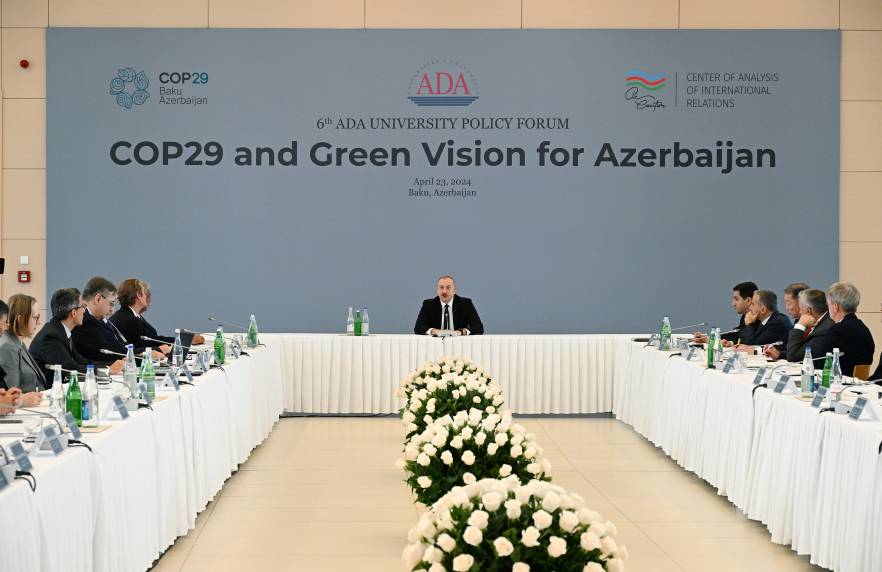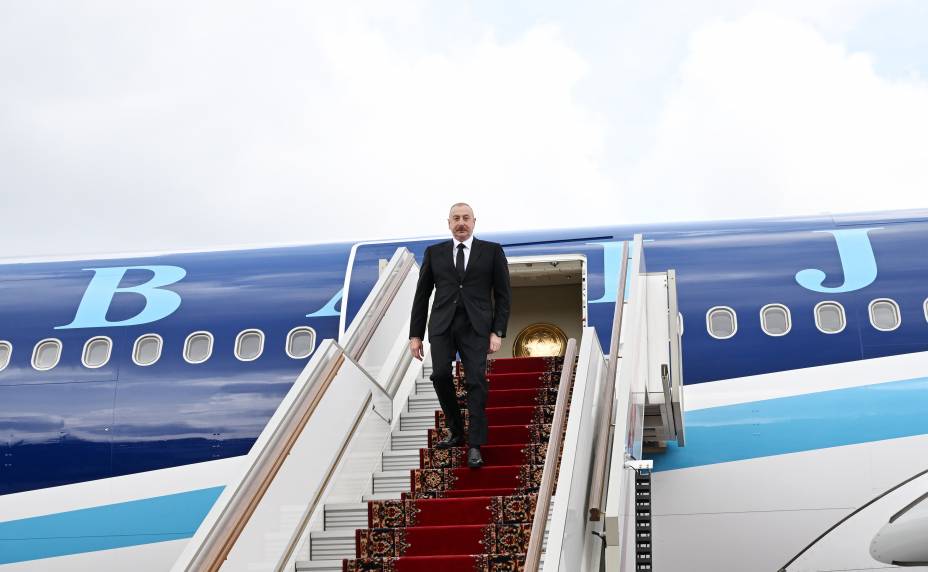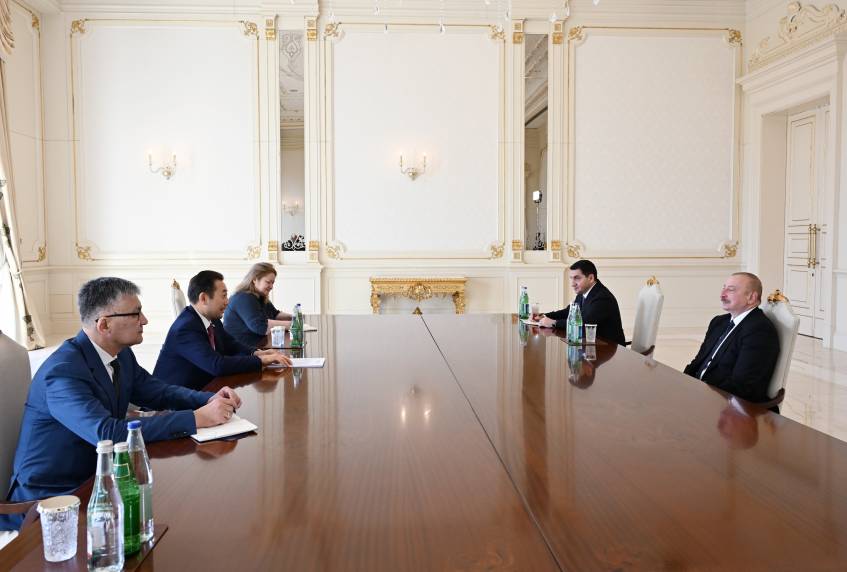14:08

Turkish weekly
Friday, 21 October 2011
VUSAL GASIMLI
Introduction
During the years from 2000 to 2010, Azerbaijan achieved the boosting of its export volume by more than fifteen times. Although the lion’s share of export volume belongs to resources, the Azerbaijani government supports several sectors demonstrating high potential for income growth, employment, export expansion, or the ability to competitively substitute for imports. The Azerbaijan Export and Investment Promotion Agency (AZPROMO) was established to support the development of Azeri non-oil sectors. The promotion of exports is universally viewed by governments around the world as a vital public function, one that generates good jobs and projects their nation´s brand into global markets. Thirty years of trade expansion that regularly outpaces economic growth helps to reinforce the conclusion that export promotion is working.[1]
Productive Export Fields in a Diversified Economy
Azerbaijan’s most competitive non-oil fields with export potential have been defined through various research papers. Apples, cherries, grapes, apple juice, unripe potatoes, greenhouse vegetables, and the carpet industry have high levels of comparative advantage as measured by domestic resource cost analysis[2]. More than other agricultural commodities, fruits, vegetables, and dairy lend themselves to higher-value marketing opportunities, higher incomes, more employment, and multiplier effects, and as repeatedly empirically confirmed by several studies, Azerbaijan has a comparative advantage in their production[3]. The World Bank rural development strategy notes that high-value products like fruits, vegetables, and dairy provide an opportunity for farmers in transition countries to compete for a share of lucrative export markets[4]. Sensitivity analysis in the Policy Framework Paper shows that fruits, vegetables, and dairy would remain competitive even under conditions of 20% lower world prices or a 20% appreciation of Azeri manat[5]. Similar results were presented by a study prepared by the Center of Economic Reforms of the Ministry of Economic Development of Azerbaijan using the Balassa index revealed comparative advantage indices. This study showed that some products, such as agricultural tobacco, apple, nuts, tea, vegetables, oil seeds, raw cotton, pharmaceutical plant growing and processing (fruit juices, cigarettes, manufactured tobacco, animal skins, cotton linters, carded and combed cotton, cotton seed oil, sunflower oil), the oil industry (kerosene and medium oils, motor spirit and light oils, gas oils, fuel oils), and the chemical and petrochemical industry (ethylene, polyacetals and polyethers, polyethylene and plastics) have very high export potential[6]. Due to the small farm size, abundance of labor, and favorable natural resource endowments of the country, Azerbaijan’s comparative advantage lies in the production of fruits and vegetables such as oranges, apples, olives, tomatoes, cabbage, and chickpeas, and livestock products such as beef and milk[7].
The trade intensity index (TI) is used to determine whether the value of trade between two countries is greater or smaller than would be expected on the basis of their significance in world trade. It is defined as the share of one country’s exports going to a partner divided by the share of world exports going to the partner. The highest level of trade intensity is recorded for vegetable, fruit, animal and vegetable fats for Azerbaijan[8]. As a result, it is likely that foreign demand holds the most potential opportunities for growth and profit in the fruit and vegetable sectors. By contrast, the livestock sector would have a difficult time exporting due to the current poor state of collection and processing in the sector, and competition from low-cost neighbors (such as Turkey and Russia)[9].
Avenues of Export Promotion
AZPROMO successfully provides country image building, export support services, marketing, and market research. The largest share of the budget of the export promotion agencies is generally spent on marketing and market research and publications around the world. According to the data set covering 104 developing and developed countries, for each US dollar of export promotion, we estimate a 40 US dollar increase in exports[10]. AZPROMO has a positive and statistically significant impact on national exports. The efficiency of AZPROMO monotonically increases with GDP per capita.
The Azerbaijani government uses scientific grounds for choosing criteria for the export promotion strategy: products with a comparative advantage, trade partners more lucrative in terms of export, and export-directed enterprises having vertical coordination. The classification of government strategy based upon products is as follows: a) enterprise; b) sub-sector; c) sector; d) cluster; e) non-oil sector.
In enterprise-level activities for export promotion, different tools are being looked through so that export growth will occur as a result of this accomplishment. The export promotion strategy of the Azeri government is based on the following pillars:
Pillar 1: Providing corporate technical support: a) Enhancing available information of food safety by delivering documentation including developing audit checklists for food safety programs (SSOPs, GMPs, GAP, HACCP, and various ISO standards); b) Broadening information about directives, Harmonized European Standards, other purely national requirements in the field of packaging and certification, etc. World Bank surveys in 18 countries suggest that caution should be exercised when contemplating the provision of such skills[11]. The government works closely with other organizations such as business development centers and entrepreneur associations to deliver the services.
Pillar 2: Enhancing available information. AZPROMO might support this with the simple and understandable Foreign Market Access Database, which includes: a) The rates of import custom duties of the third countries, inland taxes, customs procedures, sanitary and phytosanitary measures, and other requirements/procedures that are to be taken into consideration when importing the goods into the respective country; b) The descriptions of import licensing procedures and customs procedures; c) The market research data about the markets of third countries; d) More participation in international exhibitions and trade missions, sector-specific identification and promotion, and strengthening regional offices.
Pillar 3: Government support to exporters in terms of PR, Government Relations (GR), grassroots activism, and B2B relations.
Geographical Diversification
Another approach directed toward export promotion grounded on foreign markets is broken into a) traditional markets (such as the CIS); b) developing markets (such as Turkey) and c) developed markets (such as the EU, U.S., and Canada). Development of international markets that increasingly demand higher quality obliges Azerbaijani exporters to keep in hand the traditional markets while striving for new niches in the markets of developed countries. The Azeri government, based on the export similarity, trade complementarity, etc. supports the directing of exporters toward more attractive trade partners. About 93% of agricultural goods and foods produced in Azerbaijan are exported to CIS countries. Russia accounts for a majority of the exports among CIS countries (about 90-100%) followed by Ukraine and Georgia. The high-level share of Russia in the exports of Azerbaijan is explained by several factors. First of all, historical relations play an important role. Thus, Azerbaijan used to meet 20-30% demand of former Soviet republics for fresh fruits and vegetables[12]. There is a high demand for fruits and vegetables produced in Azerbaijan with a high competitive advantage and relevant products made with them in the traditional Russian market. Thus, more than 50% of the demand for fruits and 10-15% of the demand for vegetables in Russia is met by the imported products. In order to have a broad view of the market scale, it should be noted that the 10% import demand for vegetables in Russia accounts to 1.6 million tons. About 80% of the demand for frozen fruits and vegetables is met by imports. According to forecasts, while the demand for fruit in Russia will increase 20.1%, local production will rise 7.1%. Similarly, there are increased rates in the demand for vegetables and local production will amount to 10.1% and 3.9% respectively. It should be noted that there is also great demand for meat and dairy products in Russia, where Azerbaijan has potential comparative advantages[13].
In the Black Sea Economic Cooperation (BSEC) region, the trade complementarity index reveals that Azerbaijan’s exports match very closely the imports of Greece (65%), Ukraine (64%), and Romania (63%)[14]. Such a kind of approach confirms the priority of a long-term export strategy directed toward the EU and other developed markets while keeping traditional markets. The complementarity index between the economies of Turkey and Azerbaijan grew from 0.13 in 2000 to 0.17 in 2007[15]. This shows the extent of the matching possibility of the export structure of Azerbaijan with the import structure of Turkey and vice versa. The lower value of the complementarity index indicates potential competitiveness between the two countries and higher value means potential complementarities.
A successful foreign trade policy pursued over the recent years created an opportunity for the export of goods from Azerbaijan to developed countries on privileged terms. Thus, the Republic of Azerbaijan, which enjoys Generalized Systems of Preferences (GSP) with Canada, Japan, Norway, and Switzerland, is included in the GSP+ program of the EU and GSP program of the .U.S. in December, 2008. While the total level of imports in the world amounted to USD 14.2 trillion in 2007, this figure was more than USD 9 trillion for countries offering the GSP to Azerbaijan. The share of countries that included Azerbaijan into the GSP and those creating privileged export opportunities for goods produced in Azerbaijan in the import total is 63%. There is an opportunity for goods produced in the country to be exported to 66% of the world import markets on privileged terms, taken into account the existence of Free Trade Agreements between Azerbaijan and countries covering 3% of the world’s imports. Analysis of the export indicators of Azerbaijan for 2008 suggests that 75% of the overall exports of the country were implemented with countries applying the privileged regime. The share of countries applying the privileged regime to the exports of Azerbaijan is 70%, excluding the export of crude oil.
Furthermore, export promotion is conducted by focusing internally on regions. The cluster mapping, which covers all regions of Azerbaijan, suggests where existing strengths may lie.
*Dr. Vusal Gasimli is Leading Research Fellow at the Center for Strategic Studies in Baku, Azerbaijan.
Link to article

22 апреля завершился рабочий визит Президента Азербайджанской Республики Ильхама Алиева в Российскую Федерацию.
22 апреля 2024, 23:1322 апреля в Москве состоялся совместный обед Президента Азербайджанской Республики Ильхама Алиева и Президента Российской Федерации Владимира...
22 апреля 2024, 20:48
На 11-м заседании Исполнительного совета Молодежного форума Организации исламского сотрудничества, состоявшемся 10 ноября 2023 года в городе...
17 апреля 2024, 16:55Президенту Азербайджанской Республики Его превосходительству господину Ильхаму Алиеву
Ваше превосходительство.
От имени правительства и...
17 апреля 2024, 12:22
16 апреля Президент Республики Сербия Александар Вучич позвонил Президенту Азербайджанской Республики Ильхаму Алиеву и, проинформировав его о...
16 апреля 2024, 20:36Руководствуясь пунктом 32 статьи 109 Конституции Азербайджанской Республики, постановляю:
Назначить Фархада Аскер оглу Адыгезалова...
16 апреля 2024, 13:48Руководствуясь пунктом 32 статьи 109 Конституции Азербайджанской Республики, постановляю:
Освободить Айдына Мунсуф оглу Ибадова от должности...
16 апреля 2024, 13:46